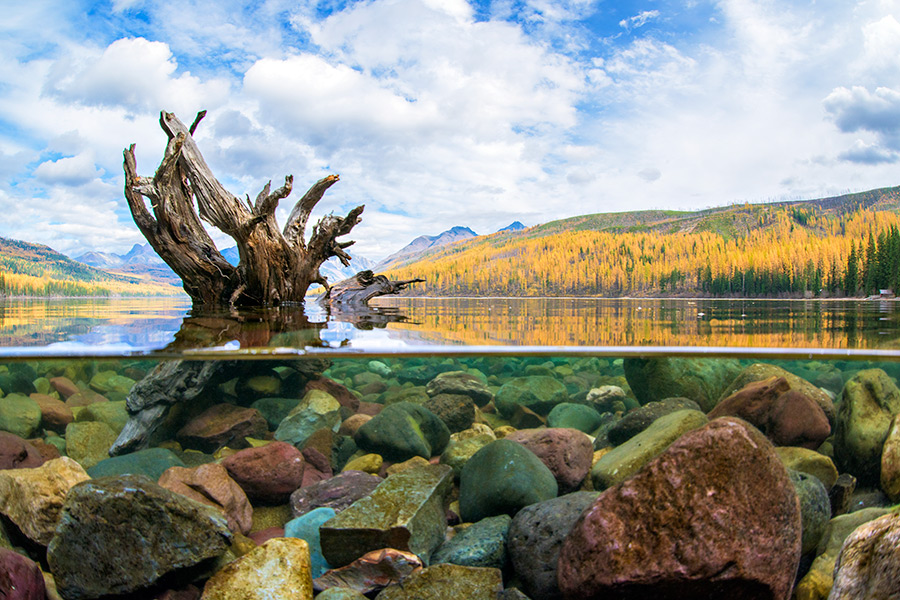Photographer Chris Gug is accustomed to immersing himself in his work, having captured underwater images of seascapes, shipwrecks and marine life in more than 40 countries.
His most recent month-long assignment as artist-in-residence at Glacier National Park was an opportunity to dive into new territory, however – professionally, geographically and literally.
The Florida-based photographer has been scuba diving and shooting underwater photography since he was 15 years old, with his travels taking him to shoots in warm climes, submerged in sun-soaked bodies of water in the Caribbean and off the coast of Papa New Guinea.
But when he stumbled serendipitously upon Glacier’s artist-in-residence program (he was Google searching information about artists and the Fort Lauderdale Airport expansion, and the logarithm inexplicably led him to Glacier) his interest was piqued.
Gug had already been exploring a new concept through a photo series he calls the “New Americana Project,” in which he juxtaposes landscapes that have been famously featured by photographers, like Ansel Adams, but from a partially submerged underwater perspective.
He calls it a “split-shot,” and by half-submerging his 9.5-inch lens port, he merges the crystal-clear underwater perspective with the eye-popping mountainscapes above the surface.
Between Oct. 6 and Nov. 1, Gug dove in Glacier’s many lakes and streams, capturing autumnal images at and beneath Iceberg Lake, Kintla Lake, Lake McDonald, McDonald Creek, Upper Grinnell Lake, Hidden Lake, Paola Creek, and more.
One split image shows a spray of golden alpine larch stands bristling along the shore of Kintla, radiating above the burnished pastels of Lake Kintla’s brilliant bottom-stones.
“I had never even heard of a larch,” he said. “We caught Kintla right at peak of the larch turn. The trees were so amazing, and the rocks underwater are just as pretty.”
Along with his partner, assistant and gallery manager Suzanne Bushnell, Gug explored the park at depth, diving at Lake McDonald’s underwater forest east of Sprague Creek, where trees rise vertically from the lake’s silt bottom. He swam beneath the ice formations near Grinnell Glacier, trying to capture underwater split-images in the split-second window of time before the lens port of his camera froze in the 40 mph winds.
“Grinnell Lake had three inches of ice on it, and I was trying to shoot split-shots through the ice chunks, but with the wind whipping the snow off the mountains I had to really learn a new technique to keep ice off my port,” he said. “On second thought, the hardest part of that shoot was getting out of my hiking gear and into my dry suit. It was just numbingly painful.”
While Gug focuses his work on underwater landscapes and vistas, he’s also fascinated in marine life. Once he’d captured the wide-angle, fish-lens images he wanted, he turned his attention to shooting lake life on a macro scale.
Caddisfly larvae, colonial bryozoan, native sculpin fish, leeches, snails, and – to his delight – freshwater sponges.
“I found just as much to photograph on a macro-scale in Lake McDonald than I have in any coral reef,” he said.
Gug recently gave a presentation of his Glacier Park artist-in-residence stint at his gallery in Fort Lauderdale, Florida, and said of the more than 100 attendees only about a dozen had visited.
Although Gug hopes to share the majesty of Glacier through his images, he also realizes that the park is in danger of being loved to death.
“I really speak from my heart about Glacier National Park as one of the most fabulous frontiers, especially out of season when there are no humans around,” he said. “There were so many days where we didn’t see a single other person. It brings back the spirit of adventure in this day and age of always being plugged in and removed from the wild.”
View more of Gug’s work at: www.GugUnderwater.com or on his Facebook page at https://www.facebook.com/GugUnderwater
